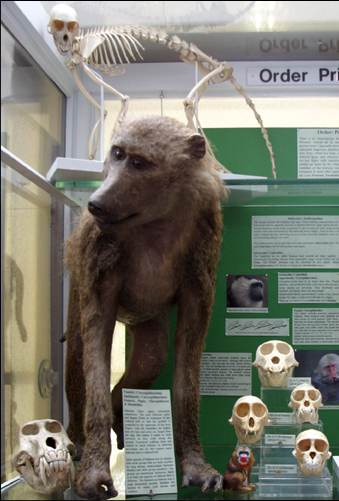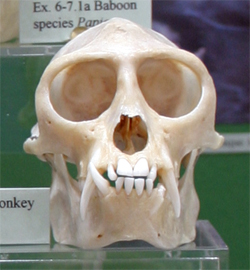
SUBORDER HAPLORHINI
INFRAORDER CATARRHINI
SUPERFAMILY CERCOPITHECOIDEA
OLD WORLD MONKEYS
Old World Monkeys are grouped together with apes in the infra-order Catarrhini because the nostrils of both groups are narrow and close together. The name catarrhine literally means ‘drooping nose’. Within the infraorder Catarrhini, monkeys are assigned to the Superfamily Cercopithecoidea, while apes and humans are assigned to the superfamily Hominoidea. The two lineages of modern catarrhine monkeys are assigned to a single family, the family Cercopithecidae.
 |
 |
FAMILY CERCOPITHECIDAE
Old World Monkeys are found in Africa, Asia and Gibraltar, hence the term ‘Old World’. They tend to be larger than New World monkeys. As a group, these monkeys show a shortening of the face with the nostrils becoming one unit. The upper lip is enlarged and has muscles which help in feeding, facial expression and vocalisation. Cercopithecines have well developed opposable thumbs and big toes which grip well. Their fore limbs and hind limbs are usually the same length. Their tails may be very long but are not prehensile, some have reduced tails or even lack tails. Some are arboreal, many species are terrestrial. They have hard pads on the lower sides of their buttocks for sitting on – the ischial callosities. Old World monkeys are more sexually dimorphic than New World monkeys: males are larger, genders may differ in colour, the males’ skulls and canine teeth are larger than the females’.
SKULLS AND DENTITION
|
All monkey skulls have large and globular brain cases, their orbits face forward and there is a virtually complete plate behind the orbit. Baboons have a well-developed snout but most monkeys do not. The frontal bones fuse early in life. The two halves of the lower jaw are fused together and the body of the jaw is typically deep. Their teeth include spatulate (shovel-shaped) incisors, conspicuous canines and squared off molar teeth with four cusps. All Old World monkeys have the same dental formula: I2/2; C1/1; P2/2; M3/3 = 32, which differs from that of New World monkeys. They have fewer teeth than cebid monkeys due to the absence of one pair of upper premolars and one pair of lower premolars. They have the same number of teeth as marmosets but have fewer premolars and more molars than marmosets. The molars have a distinctive cusp pattern of four cusps joined in pairs by transverse ridges. The differences in the sizes of the skulls of male and female Old World Monkeys may be very pronounced with the skull of the male of a species being twice as heavy as the skull of the female. The canines of males are large and used for defence. The canines are sharpened by honing against the front edge of the lower premolars. |  |
THE TWO LINEAGES OF THE OLD WORLD MONKEYS
Modern catarrhine monkeys belong to a single family, the family Cercopithecidae, whose members are divided between the subfamilies Cercopithecinae and Colobinae. The subfamily Cercopithecinae contains 45 species of cheek pouch or ‘typical’ monkeys. Guenons, baboons and macaques are distinguished by the possession of cheek pouches for storing and carrying food. The sub-family Colobinae contains 37 species of leaf-eating monkeys. Colobus monkeys, leaf monkeys and langurs are distinguished by the possession of a sacculated stomach in which leaves are digested by bacterial fermentation.
| SUBFAMILY CERCOPITHECINAE | SUBFAMILY COLOBINAE |






